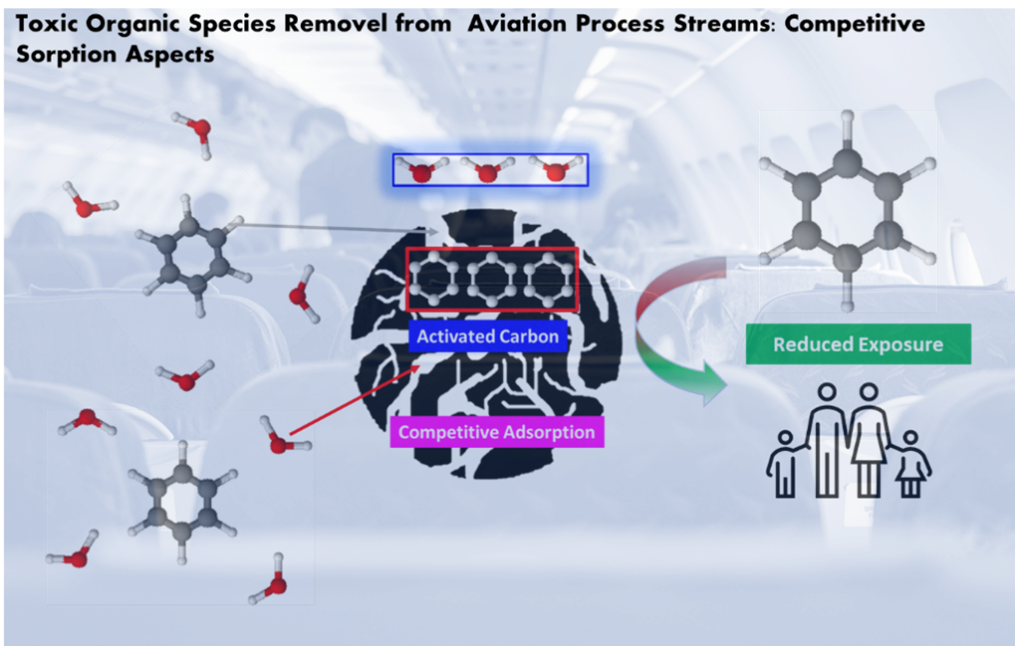Navigation menu
- Education
- Emissions & Air Quality
- Infrastructure & Services
- Meteorology & Climate
- News
- Physical Chemistry
- Projects
- The Team

Overview
Airborne pollutants can have negative physiological impacts on passengers and crew members in the short- and long-term, hence aircraft cabin air quality is very important to human wellbeing. Due to their detrimental effects on human health, volatile and semi-volatile organic compounds, also known as VOCs and SVOCs, must be eliminated from the cabin air. These compounds include cancer-causing substances such as benzene, formaldehyde, 1,2-dichloroethane, and naphthalene. There are many sources of toxic VOC species in aviation, such as exhaust fumes, de-icing fluids, jet engine oils, lubricants, and hydraulic fluids, which can have a negative impact on health. Up to 20 air pollution incidents are documented each year because of the release of noxious species into cabin during flight crises, which can result in a wide range of passenger ailments generally described as aero-toxic syndrome. Thus, it is crucial to have Environmental Control Systems (ECS) that can efficiently remove harmful VOC and SVOC species while safeguarding staff and passengers.
Problem
Currently, HEPA filters can remove airborne particles down to 0.3 m in diameter, but they cannot get rid of volatile organic compounds (VOCs), which can be harmful even in extremely low concentrations and mostly enter the body through the respiratory system. Dispersion inside the cabin environment of an aeroplane is influenced by the organic compound vapour pressure, the severity of technical faults (such as leaks), air circulation dynamics, and the current weather conditions. The use of porous sorbent materials, which can remove and trap the species within the porous structure, is the most economical way to safeguard passengers and staff. The best adsorbent for VOC elimination applications is activated carbon. This is attributed to the material’s highly developed porous structure, which offers high adsorption capacity and rapid adsorption kinetics, both of which are necessary elements for efficient VOC removal systems. Additionally, their wide pore size distribution allows them to adsorb a variety of VOC species.
Solution
In the actual world, VOCs need to be absorbed from water vapor-containing process streams. The presence of water vapour could seriously diminish the contaminant removal performance of cabin air purification systems designed to improve air quality and remove harmful organic species, such as VOCs. This can put passengers and personnel at risk, as harmful levels of noxious compounds could build up in the cabin environment. The battle between water and organic species removal within the pores of purification systems is known as competitive adsorption, and this must be understood in detail if air purification systems are to be successfully optimised. This area of research will now be pursued at the Centre for Aviation. Understanding the variables that regulate the VOC adsorption process in the presence of water vapour is therefore crucial, as shown in Figure 1. To date, extensive research on the competitive sorption of VOCs and H2O on activated carbon has received little attention, owing to the experimental complexity and lack of available methodologies in elucidating this topic. Experimental methods are currently being developed at the Centre for Aviation to examine the VOC and water adsorption characteristics of activated carbon materials. These materials will be investigated under competitive adsorption settings, which will lead to a better understanding of vapour-solid phase interactions and enhanced treatment of aviation air purification systems.